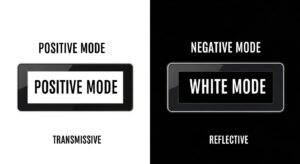Introduction
In over a decade working in LCD and display modules, I’ve often found myself comparing the benefits of E-Ink and LCD. While both have unique advantages, the context of their use greatly impacts the right choice. Here’s an in-depth comparison drawn from real-world application, backed by technical insights.

1. E-Ink vs. LCD: Eye Comfort and Blue Light Emission
Eye Comfort: Eye strain is a significant concern in digital displays, especially for those who read or view screens for extended periods. E-Ink displays, often used in e-readers, emit no blue light, offering a paper-like reading experience that closely mimics natural light reflection. This “reflective” technology requires ambient light to view the display, which can help reduce strain. In contrast, LCDs rely on backlighting, which typically includes blue light, a factor in eye strain and fatigue. Studies show that prolonged exposure to blue light, especially in the 415–455 nm range, can disrupt sleep cycles and increase discomfort for users.
“Blue Light Emission Standards: WHO’s guidelines on blue light’s impact on sleep cycles and eye health – “Environmental and Health Effects of Light” by WHO.”
Data on Blue Light Emission:
- E-Ink: Reflective technology, E-Ink displays work on reflective technology, mimicking natural paper. They don’t emit light directly, making them a popular choice for devices intended for extended reading. Since E-Ink displays do not require a backlight, they produce minimal blue light—significantly under the 450nm range that is associated with eye strain.
- LCD: Emits blue light in the 415–455 nm range. For context, many ophthalmologists recommend avoiding exposure above 420 nm for extended periods to reduce eye strain. “Check our page on Custom LCD Solutions for tailored options that consider eye comfort.”
Personal Insight: From my experience in the LCD field, I often advise customers who prioritize eye comfort, particularly those developing e-readers or display devices for extended reading, to consider E-Ink over LCD. Users reading for hours on end tend to experience less strain with E-Ink displays.
2. Power Consumption: Which Display Lasts Longer?
E-Ink and Power Efficiency: One of E-Ink’s most celebrated benefits is its exceptionally low power usage. E-Ink displays require power only when the screen refreshes, allowing devices like e-readers to run for weeks on a single charge. By contrast, LCDs require constant power to maintain brightness and display content, significantly impacting battery life.
Power Consumption Research: Study by IEEE on power usage in various display technologies – “Energy Efficiency in Electronic Displays: Comparative Study of E-Ink and LCD” on IEEE Xplore.
Data on Blue Light Emission:
- E-Ink: E-Ink displays are extremely energy efficient, as they only consume power when the screen content is updated. For example, eReaders like the Kindle can last weeks on a single charge, making E-Ink ideal for battery-dependent or off-grid applications.
- LCD: LCDs consume power continuously to maintain the backlight and refresh rates, especially in interactive or video-heavy applications. For example, a 7-inch LCD panel might draw between 10-20 mAh per hour under typical usage, which significantly impacts battery life in portable devices. “See our specialized TFT LCD Modules designed for power-sensitive applications.”
Industry Application Example: “For outdoor and portable monitoring devices, E-Ink technology reduces the frequency of recharges and maintenance. In contrast, LCDs are selected for products that require high refresh rates and visual engagement, like interactive terminals.”
3. Color Capabilities: Can E-Ink Match LCD’s Vibrancy?
Color Depth and Quality: LCD displays lead the market in color depth and vividness, supporting up to 16.7 million colors (24-bit color), making them ideal for high-definition and multimedia applications. E-Ink, however, was traditionally limited to grayscale but has recently introduced color options. These newer E-Ink color displays are limited to 4096 colors, offering less vibrant results compared to LCDs.
Outdoor Performance in Sunlight: Visibility Under Sunlight Conditions offers data on brightness and outdoor effectiveness.
Comparison of Color Depth:
- E-Ink: Traditional E-Ink is limited to grayscale, although recent models can support up to 4,096 colors. This makes E-Ink suitable for basic graphics and text but not for detailed color work.
- LCD: LCDs support full RGB, allowing for millions of colors and high resolution, which is essential for multimedia and interactive applications. For instance, industrial control panels or consumer electronics with an LCD provide vivid detail and color depth that E-Ink currently cannot match.
Industry Example: “In industries requiring precise color distinction, such as digital signage, LCDs are irreplaceable. E-Ink’s color limitations make it better suited for static, low-color applications like reading or simple graphics.”
4. Outdoor Visibility: Performance Under Direct Sunlight
Sunlight Readability: E-Ink displays excel in bright environments, using reflected light rather than emitting their own, which makes them perfectly readable even under direct sunlight. This outdoor visibility is why E-Ink is commonly used in devices like digital outdoor signage and e-readers. LCDs, on the other hand, often struggle with outdoor readability due to glare and reflection unless enhanced with anti-reflective coatings.
Color Depth and Visual Performance: Color Display Depth Study delves into the color representation capabilities of displays.
Outdoor Performance Metrics:
- E-Ink: E-Ink displays are visible under direct sunlight without glare, making them ideal for outdoor applications. In fact, many E-Ink screens retain readability at up to 100,000 lux.
- LCD: LCD screens are often difficult to view in direct sunlight due to glare and reflections. Even with anti-reflective coatings, LCD screens lose 30-50% visibility in bright outdoor environments. For instance, iPad LCD screens typically require additional adjustments to be legible outdoors. “Explore our Monochrome Displays for outdoor applications.”
Recommendation for Outdoor Devices: “For signage or devices used outdoors, such as field data recorders or rugged tablets, E-Ink provides clearer visibility without added power draw. LCDs with anti-reflective technology can also work, but are typically limited to shaded or indirect light conditions.”
5. Refresh Rate: Which Display Handles Motion Better?
Refresh Rate Comparison: For static content, E-Ink’s slower refresh rate (around 0.5 Hz) is adequate, but it’s unsuitable for dynamic content due to “ghosting,” or residual images that persist during refresh. In contrast, LCDs operate at refresh rates from 60 Hz to 120 Hz, handling video playback and motion content smoothly.
Refresh Rates: IEEE Refresh Rate Comparisons explores various displays’ refresh rates and motion performance.
Refresh Rate Data:
- E-Ink: Refresh rate lags at around 1 Hz, which limits E-Ink for static images rather than video or interactive applications. This slow refresh rate, while ideal for text, cannot match the dynamic capabilities of LCD.
- LCD: Typical refresh rates range from 60 Hz to 120 Hz in high-end devices, supporting video playback and real-time interactions.
Industrial Use Case: “For data displays and control interfaces that need fast response, like in production monitoring or real-time data feeds, LCD is the go-to technology. In contrast, E-Ink’s slower refresh is well-suited for static information, reducing power usage and eye strain.”
Conclusion
For manufacturers, distributors, and integrators, the choice between E-Ink and LCD depends heavily on application demands:
- E-Ink: Ideal for low-power, static, outdoor, and eye-comfort-sensitive applications. Common uses include eReaders, simple signage, and outdoor display panels.
- LCD: Best for high-resolution, color-rich, interactive, and video-enabled applications. LCD screens are widely used in industrial control panels, medical devices, consumer electronics, and other dynamic-use scenarios.
FAQ
1. What are the key differences between E-Ink and LCD displays?
E-Ink displays are ideal for static content, providing excellent readability in sunlight and low power consumption, making them suitable for devices like eReaders and outdoor signage. LCDs, on the other hand, support high refresh rates and vivid color displays, perfect for interactive, multimedia applications such as smartphones and control panels.
2. Is E-Ink better than LCD for eye comfort?
Yes, E-Ink is generally considered better for eye comfort due to its reflective technology, which doesn’t emit blue light directly. This reduces eye strain, especially for extended reading. LCD displays emit more blue light, which can contribute to eye fatigue over long use periods.
3. How does power consumption differ between E-Ink and LCD displays?
E-Ink is highly energy-efficient, only using power when the display changes, making it ideal for low-power applications. LCD displays consume more power continuously to maintain backlighting and higher refresh rates, which can drain batteries faster, particularly in portable devices.
4. Which is better for outdoor readability, E-Ink or LCD?
E-Ink outperforms LCD in outdoor readability, as it reflects natural light rather than relying on backlighting, thus avoiding glare and reflections in direct sunlight. LCDs typically require anti-reflective coatings to improve visibility in bright light, but E-Ink remains superior in outdoor environments.
5. What types of applications are best suited for E-Ink and LCD displays?
E-Ink is best for applications where static content, power efficiency, and eye comfort are prioritized, such as eReaders and outdoor signage. LCD is more suitable for applications requiring vivid color, high refresh rates, and interactive functionality, like control panels, smartphones, and multimedia devices.







